Study on Purification Efficiency of Novel Aquatic Plant Combinations and Characteristics of Microbial Community Disturbance in Eutrophic Water Bodies
Abstract
1. Introduction
2. Materials and Methods
2.1. Preparation of Plant Materials and Pot Experimental Design
- (1)
- LNM group: Lythraceae, Nymphaea, and Myriophyllum;
- (2)
- LNH group: Lythraceae, Nymphaea, and Hydrilla verticillata;
- (3)
- LNV group: Lythraceae, Nymphaea, and Vallisneria;
- (4)
- CK group: contained only sediment and culture water without any plants.
2.2. Physicochemical Analysis
2.3. Microbial Community Analysis
3. Results and Discussion
3.1. Performances of Pollutant Removal
3.1.1. COD Removal
3.1.2. NH4+-N and TN Removal
3.1.3. TP Removal
3.2. Microbial Communities Analysis
3.2.1. Microbial Community Structure
3.2.2. Dominant Community at Phylum Level
3.2.3. Dominant Community at Class Level
3.2.4. Dominant Community at Genus Level
4. Conclusions
Author Contributions
Funding
Data Availability Statement
Conflicts of Interest
References
- Zamparas, M.; Zacharias, I. Restoration of eutrophic freshwater by managing internal nutrient loads. A review. Sci. Total Environ. 2014, 496, 551–562. [Google Scholar] [CrossRef] [PubMed]
- Preece, E.P.; Hardy, F.J.; Moore, B.C.; Bryan, M. A review of microcystin detections in Estuarine and Marine waters: Environmental implications and human health risk. Harmful Algae 2017, 61, 31–45. [Google Scholar] [CrossRef]
- Zhao, Y.; Fang, Y.; Jin, Y.; Huang, J.; Ma, X.; He, K.; He, Z.; Wang, F.; Zhao, H. Microbial community and removal of nitrogen via the addition of a carrier in a pilot-scale duckweed-based wastewater treatment system. Bioresour. Technol. 2015, 179, 549–558. [Google Scholar] [CrossRef] [PubMed]
- Bhateria, R.; Jain, D. Water quality assessment of lake water: A review. Sustain. Water Resour. Manag. 2016, 2, 161–173. [Google Scholar] [CrossRef]
- Xu, J.; Shen, G. Growing duckweed in swine wastewater for nutrient recovery and biomass production. Bioresour. Technol. 2011, 102, 848–853. [Google Scholar] [CrossRef]
- Segura, A.; Ramos, J.L. Plant–bacteria interactions in the removal of pollutants. Curr. Opin. Biotech. 2013, 24, 467–473. [Google Scholar] [CrossRef]
- Kwon, H.K.; Oh, S.J.; Yang, H.-S. Growth and uptake kinetics of nitrate and phosphate by benthic microalgae for phytoremediation of eutrophic coastal sediments. Bioresour. Technol. 2013, 129, 387–395. [Google Scholar] [CrossRef]
- Srivastava, J.; Gupta, A.; Chandra, H. Managing water quality with aquatic macrophytes. Rev. Environ. Sci. Bio/Technol. 2008, 7, 255–266. [Google Scholar] [CrossRef]
- Huss, A.A.; Wehr, J.D. Strong Indirect Effects of a Submersed Aquatic Macrophyte, Vallisneria americana, on Bacterioplankton Densities in a Mesotrophic Lake. Microb. Ecol. 2004, 47, 305–315. [Google Scholar] [CrossRef]
- Han, B.; Zhang, S.; Wang, P.; Wang, C. Effects of water flow on submerged macrophyte-biofilm systems in constructed wetlands. Sci. Rep. 2018, 8, 2650. [Google Scholar] [CrossRef]
- Lu, Q.; He, Z.L.; Graetz, D.A.; Stoffella, P.J.; Yang, X. Phytoremediation to remove nutrients and improve eutrophic stormwaters using water lettuce (Pistia stratiotes L.). Environ. Sci. Pollut. Res. 2010, 17, 84–96. [Google Scholar] [CrossRef]
- Mayo, A.W.; Hanai, E.E. Modeling phytoremediation of nitrogen-polluted water using water hyacinth (Eichhornia crassipes). Phys. Chem. Earth Parts A/B/C 2017, 100, 170–180. [Google Scholar] [CrossRef]
- Xu, X.-J.; Lai, G.-L.; Chi, C.-Q.; Zhao, J.-Y.; Yan, Y.-C.; Nie, Y.; Wu, X.-L. Purification of eutrophic water containing chlorpyrifos by aquatic plants and its effects on planktonic bacteria. Chemosphere 2018, 193, 178–188. [Google Scholar] [CrossRef] [PubMed]
- Xiao, H.; Peng, S.; Liu, X.; Jia, J.; Wang, H. Phytoremediation of nutrients and organic carbon from contaminated water by aquatic macrophytes and the physiological response. Environ. Technol. Innov. 2021, 21, 101295. [Google Scholar] [CrossRef]
- Samsó, R.; García, J. Bacteria distribution and dynamics in constructed wetlands based on modelling results. Sci.Total Environ. 2013, 461, 430–440. [Google Scholar] [CrossRef] [PubMed]
- Hoang, H.G.; Thuy, B.T.P.; Lin, C.; Vo, D.-V.N.; Tran, H.-T.; Bahari, M.B.; Le, V.-R.; Vu, C.T. The nitrogen cycle and mitigation strategies for nitrogen loss during organic waste composting: A review. Chemosphere 2022, 300, 134514. [Google Scholar] [CrossRef]
- Minett, D.A.; Cook, P.L.M.; Kessler, A.J.; Cavagnaro, T.R. Root effects on the spatial and temporal dynamics of oxygen in sand-based laboratory-scale constructed biofilters. Ecol. Eng. 2013, 58, 414–422. [Google Scholar] [CrossRef]
- Muerdter, C.P.; Wong, C.K.; Lefevre, G.H. Emerging investigator series: The role of vegetation in bioretention for stormwater treatment in the built environment: Pollutant removal, hydrologic function, and ancillary benefits. Environ. Sci. Technol. 2018, 4, 592–612. [Google Scholar] [CrossRef]
- Zuo, X.J.; Zhang, H.S.; Yu, J. Microbial diversity for the improvement of nitrogen removal in stormwater bioretention cells with three aquatic plants. Chemosphere 2020, 244, 125626. [Google Scholar] [CrossRef]
- Cheng, R.; Zhu, H.; Shutes, B.; Yan, B. Treatment of microcystin (MC-LR) and nutrients in eutrophic water by constructed wetlands: Performance and microbial community. Chemosphere 2021, 263, 128139. [Google Scholar] [CrossRef]
- Morse, N.; Payne, E.; Henry, R.; Hatt, B. Plant-microbe interactions drive denitrification rates, dissolved nitrogen removal, and the abundance of denitrification genes in stormwater control measures. Environ. Sci. Technol. 2018, 52, 9320–9329. [Google Scholar] [CrossRef]
- Payne, E.G.I.; Pham, T.; Deletic, A.; Hatt, B.E.; Cook, P.L.M.; Fletcher, T.D. Which species? A decision-support tool to guide plant selection in stormwater biofilters. Adv. Water Resour. 2018, 113, 86–99. [Google Scholar] [CrossRef]
- Chen, X.; Peltier, E.; Sturm, B.S.M.; Young, C.B. Nitrogen removal and nitrifying and denitrifying bacteria quantification in a stormwater bioretention system. Water. Res. 2013, 47, 1691. [Google Scholar] [CrossRef]
- Jing, L.; Wang, J.K.; Zhu, W.; Pu, Y.Y.; Guan, L.L.; Liu, J.X. Monitoring the rumen pectinolytic bacteria Treponema saccharophilum using real-time PCR. FEMS Microbiol. Ecol. 2014, 87, 576–585. [Google Scholar]
- Vymazal, J. Plants used in constructed wetlands with horizontal subsurface flow: A review. Hydrobiologia 2011, 674, 133–156. [Google Scholar] [CrossRef]
- Lu, B.; Xu, Z.; Li, J.; Chai, X. Removal of water nutrients by different aquatic plant species: An alternative way to remediate polluted rural rivers. Eco. Eng. 2018, 110, 18–26. [Google Scholar] [CrossRef]
- Penton, C.R.; Deeknik, J.; Popp, B.; Bruland, G.; Tiedje, J.M.; Engstrom, P.; St, L.D. Importance of sub-surface rhizosphere-mediated coupled nitrification–denitrification in a flooded agroecosystem in Hawaii. Soil Biol. Biochem. 2013, 57, 362–373. [Google Scholar] [CrossRef]
- Du, L.; Trinh, X.; Chen, Q.; Wang, C.; Wang, H.; Xia, X.; Zhou, Q.; Xu, D.; Wu, Z. Enhancement of microbial nitrogen removal pathway by vegetation in Integrated Vertical-Flow Constructed Wetlands (IVCWs) for treating reclaimed water. Bioresour. Technol. 2018, 249, 644–651. [Google Scholar] [CrossRef] [PubMed]
- Nie, S.; Li, H.; Yang, X.; Zhang, Z.; Weng, B.; Huang, F.; Zhu, G.B.; Zhu, Y.G. Nitrogen loss by anaerobic oxidation of ammonium in rice rhizosphere. ISME J. Emultidisciplinary J. Microb. Ecol. 2015, 9, 2059–2067. [Google Scholar] [CrossRef]
- Machat, H.; Boudokhane, C.; Roche, N.; Dhaouadi, H. Effects of C/N Ratio and DO concentration on Carbon and Nitrogen removals in a Hybrid Biological Reactor. Biochem. Eng.J. 2019, 151, 107313. [Google Scholar] [CrossRef]
- Zhao, Z.; Chang, J.; Han, W.; Wang, M.; Ma, D.; Du, Y.; Qu, Z.; Chang, S.X.; Ge, Y. Effects of plant diversity and sand particle size on methane emission and nitrogen removal in microcosms of constructed wetlands. Ecol. Eng. J. Ecotechnol. 2016, 95, 390–398. [Google Scholar] [CrossRef]
- Long, M.N. Organic matter composition, microbial biomass and microbial activity in gravel-bed constructed wetlands treating farm dairy wastewaters. Ecol. Eng. 2000, 16, 199–221. [Google Scholar]
- Zhao, F.; Xi, S.; Yang, X.; Yang, W.; Li, J.; Gu, B.; He, Z. Purifying eutrophic river waters with integrated floating island systems. Ecol. Eng. 2012, 40, 53–60. [Google Scholar] [CrossRef]
- Bai, Y.; Shi, Q.; Wen, D.; Li, Z.; Tang, X. Bacterial Communities in the Sediments of Dianchi Lake, a Partitioned Eutrophic Waterbody in China. PLoS ONE 2012, 7, e37796. [Google Scholar] [CrossRef] [PubMed]
- Bouali, M.; Zrafi, I.; Bakhrouf, A.; Chaussonnerie, S.; Sghir, A. Bacterial structure and spatiotemporal distribution in a horizontal subsurface flow constructed wetland. Appl. Microbiol. Biotechnol. 2014, 98, 3191–3203. [Google Scholar] [CrossRef]
- Herlemann, D.P.R.; Manecki, M.; Meeske, C.; Pollehne, F.; Labrenz, M.; Schulz-Bull, D.; Dittmar, T.; Jürgens, K. Uncoupling of Bacterial and Terrigenous Dissolved Organic Matter Dynamics in Decomposition Experiments. PLoS ONE 2014, 9, e93945. [Google Scholar] [CrossRef]
- Björnsson, L.; Hugenholtz, P.; Tyson, G.W.; Blackall, L.L. Filamentous Chloroflexi (green non-sulfur bacteria) are abundant in wastewater treatment processes with biological nutrient removalc. Microbiology 2002, 148, 2309–2318. [Google Scholar] [CrossRef] [PubMed]
- Zuo, X.J.; Guo, Z.Y.; Wu, X.; Yu, J. Diversity and metabolism effects of microorganisms in bioretention systems with sand, soil and fly ash. Sci.Total Environ. 2019, 676, 447–454. [Google Scholar] [CrossRef] [PubMed]
- Mohamed, Z.A. Macrophytes-Cyanobacteria allelopathic interactions and their implications for water resources management a review. Limnol. Ecol. Manag. Inland Waters 2017, 63, 122–132. [Google Scholar] [CrossRef]
- Li, Z.; Kechen, X.; Yongzhen, P. Composition characterization and transformation mechanism of refractory dissolved organic matter from an ANAMMOX reactor fed with mature landfill leachate. Bioresour. Technol. 2017, 250, 413–421. [Google Scholar] [CrossRef]
- Li, J.; Li, R.; Li, J. Current research scenario for microcystins biodegradation—A review on fundamental knowledge, application prospects and challenges. Sci. Total Environ. 2017, 595, 615–632. [Google Scholar] [CrossRef] [PubMed]
- Chen, Y.; Chai, L.; Tang, C.; Yang, Z.; Zheng, Y.; Shi, Y.; Zhang, H. Kraft lignin biodegradation by Novosphingobium sp. B-7 and analysis of the degradation process. Bioresour. Technol. 2012, 123, 682–685. [Google Scholar] [CrossRef] [PubMed]
- Magic-Knezev, A.; Wullings, B.; Kooij, D.V.D. Polaromonas and Hydrogenophaga species are the predominant bacteria cultured from granular activated carbon filters in water treatment. J. Appl. Microbiol. 2009, 107, 1457–1467. [Google Scholar] [CrossRef] [PubMed]
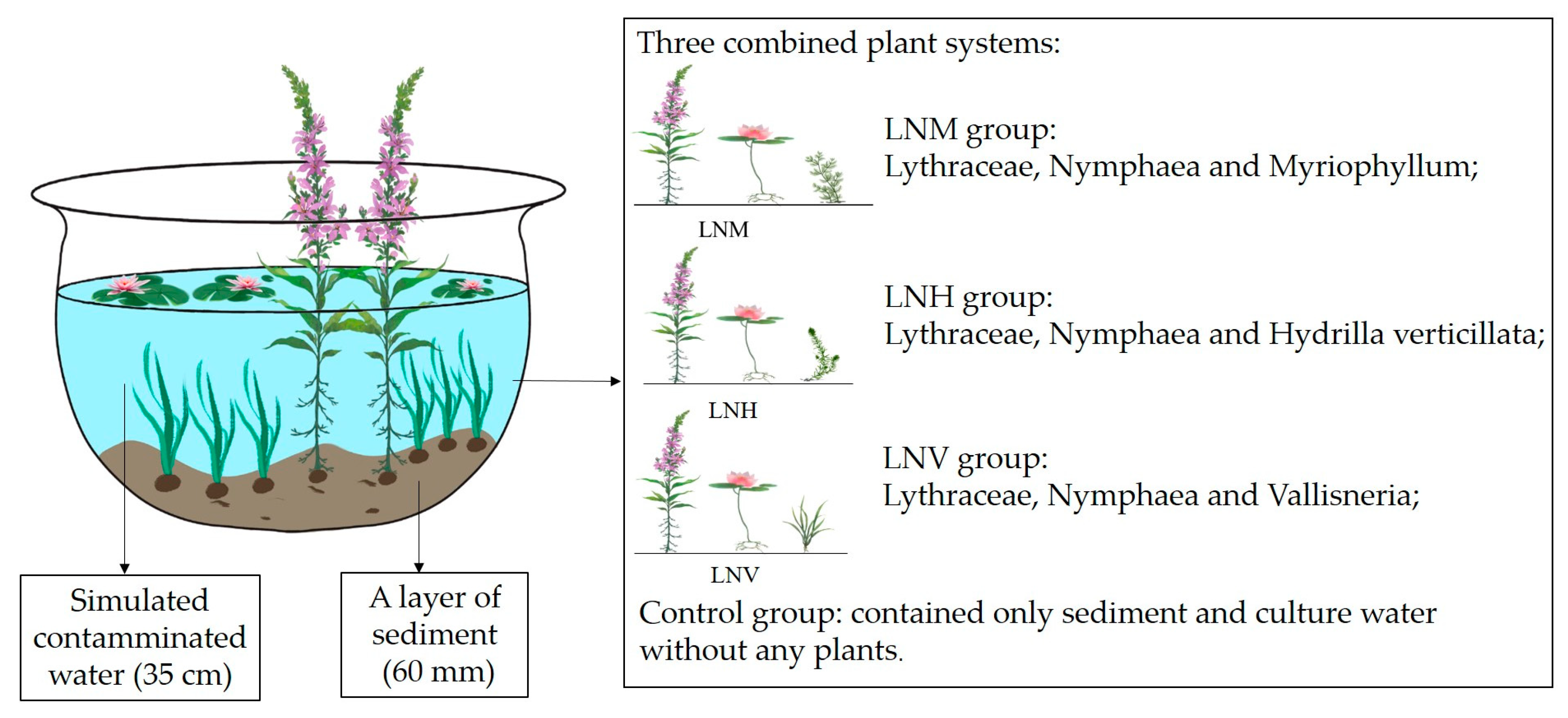

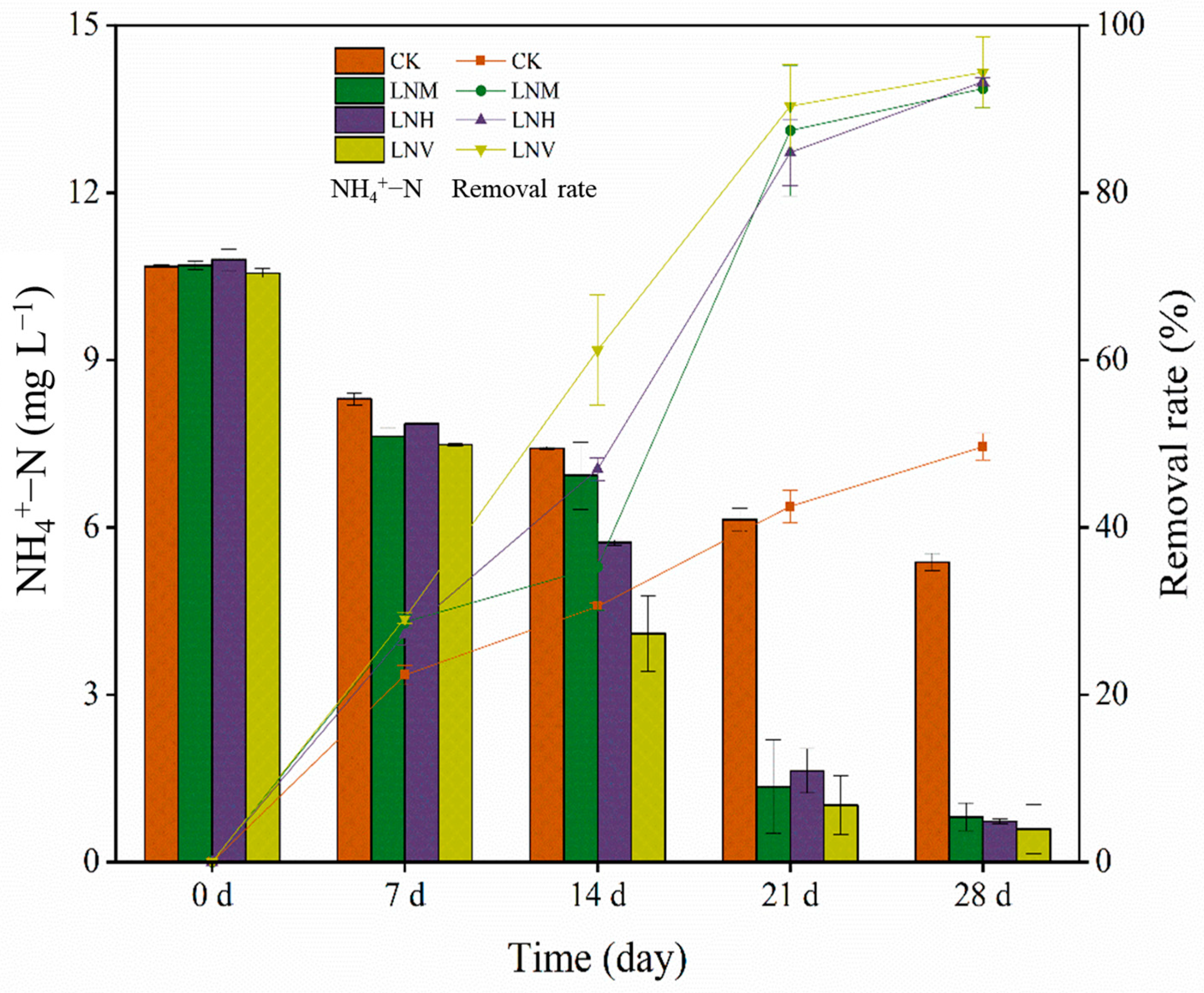

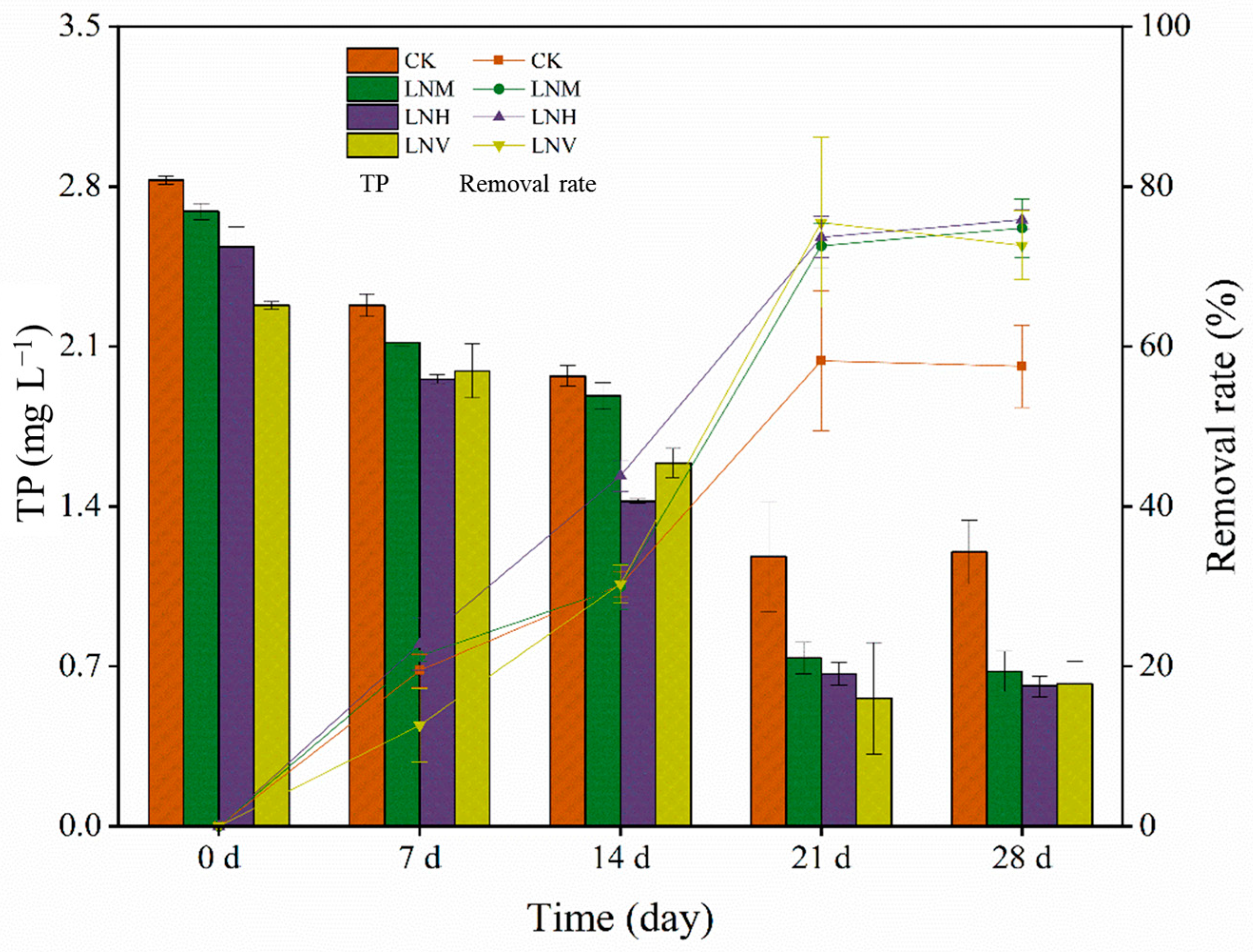

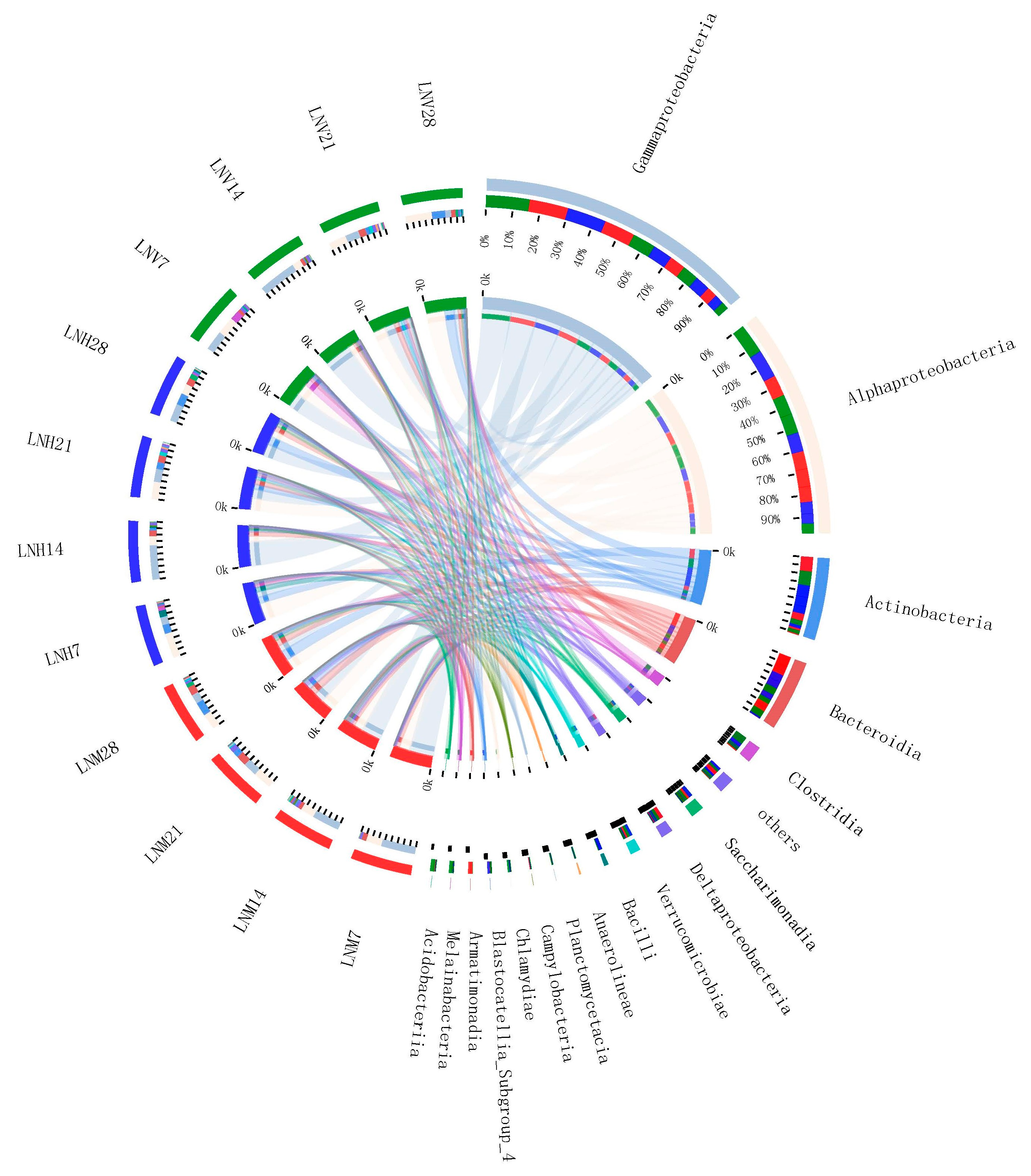
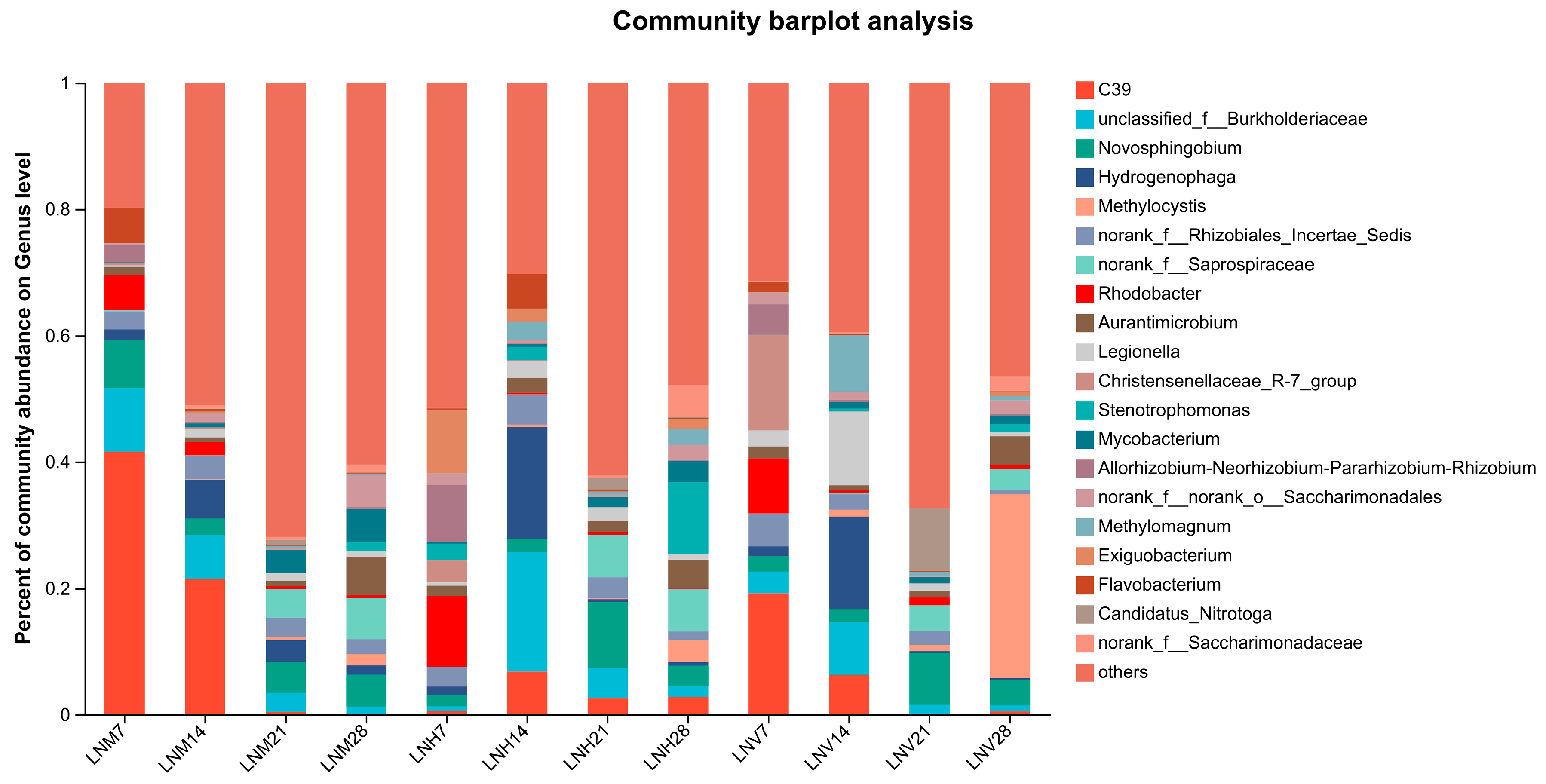
| COD (mg/L) | NH4-N+ (mg/L) | TN (mg/L) | TP (mg/L) |
|---|---|---|---|
| 50.00 ± 2.40 | 10.69 ± 0.27 | 13.22 ± 0.51 | 2.26 ± 0.19 |
| Samples | Shannon | Simpson | Chao | |
|---|---|---|---|---|
| LNM | LNM7 | 2.89 | 0.1935 | 853 |
| LNM14 | 4.31 | 0.0608 | 1472 | |
| LNM21 | 4.59 | 0.0202 | 941 | |
| LNM28 | 4.58 | 0.0222 | 1294 | |
| LNH | LNH7 | 4.27 | 0.0353 | 832 |
| LNH14 | 3.90 | 0.0575 | 1185 | |
| LNH21 | 4.55 | 0.0267 | 1035 | |
| LNH28 | 4.40 | 0.0312 | 1300 | |
| LNV | LNV7 | 3.75 | 0.0738 | 893 |
| LNV14 | 4.06 | 0.0487 | 1136 | |
| LNV21 | 4.67 | 0.0254 | 1165 | |
| LNV28 | 3.81 | 0.0983 | 1235 | |
Disclaimer/Publisher’s Note: The statements, opinions and data contained in all publications are solely those of the individual author(s) and contributor(s) and not of MDPI and/or the editor(s). MDPI and/or the editor(s) disclaim responsibility for any injury to people or property resulting from any ideas, methods, instructions or products referred to in the content. |
© 2023 by the authors. Licensee MDPI, Basel, Switzerland. This article is an open access article distributed under the terms and conditions of the Creative Commons Attribution (CC BY) license (https://creativecommons.org/licenses/by/4.0/).
Share and Cite
Jia, J.; Xiao, H.; Peng, S.; Zhang, K. Study on Purification Efficiency of Novel Aquatic Plant Combinations and Characteristics of Microbial Community Disturbance in Eutrophic Water Bodies. Water 2023, 15, 2586. https://doi.org/10.3390/w15142586
Jia J, Xiao H, Peng S, Zhang K. Study on Purification Efficiency of Novel Aquatic Plant Combinations and Characteristics of Microbial Community Disturbance in Eutrophic Water Bodies. Water. 2023; 15(14):2586. https://doi.org/10.3390/w15142586
Chicago/Turabian StyleJia, Jianna, Huan Xiao, Shitao Peng, and Kailei Zhang. 2023. "Study on Purification Efficiency of Novel Aquatic Plant Combinations and Characteristics of Microbial Community Disturbance in Eutrophic Water Bodies" Water 15, no. 14: 2586. https://doi.org/10.3390/w15142586
APA StyleJia, J., Xiao, H., Peng, S., & Zhang, K. (2023). Study on Purification Efficiency of Novel Aquatic Plant Combinations and Characteristics of Microbial Community Disturbance in Eutrophic Water Bodies. Water, 15(14), 2586. https://doi.org/10.3390/w15142586





